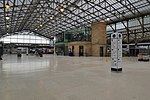Trinity Centre, Aberdeen
1984 establishments in ScotlandShopping centres in AberdeenShopping malls established in 1984Use British English from August 2017

The Trinity Centre (known as "The Mall Aberdeen" from 2006 to Dec 2009, and before that as Trinity Shopping Centre) is a one floor shopping centre in Aberdeen, Scotland. It has a two level car park. There are 408 spaces and the main entrance is on Wapping Street. Wider spaces are available for parents and children and the disabled. Car Valeting services are now also provided. The centre is located in the middle of the city with entrances on Union Street, Bridge Street and Guild Street. There is also an underground walkway that leads to Aberdeen railway station. It is built over the Aberdeen–Inverness line.
Excerpt from the Wikipedia article Trinity Centre, Aberdeen (License: CC BY-SA 3.0, Authors, Images).Trinity Centre, Aberdeen
Rennie's Wynd, Aberdeen City City Centre
Geographical coordinates (GPS) Address Nearby Places Show on map
Geographical coordinates (GPS)
| Latitude | Longitude |
|---|---|
| N 57.145555555556 ° | E -2.0994444444444 ° |
Address
Rennie's Wynd
Rennie's Wynd
AB11 6NZ Aberdeen City, City Centre
Scotland, United Kingdom
Open on Google Maps









